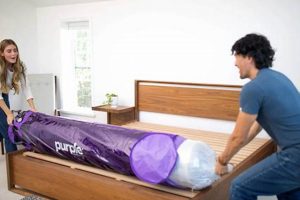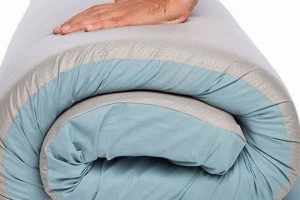An inflated sleeping surface may develop a localized protrusion, often resulting from material stretching or seam weakness. This unevenness in the sleeping area can alter the support provided, potentially compromising spinal alignment and pressure distribution.
The presence of such a deformation can reduce the overall stability of the structure, increasing the likelihood of rolling off during sleep. Further, prolonged use with such a defect might exacerbate the issue, leading to complete failure of the inflatable. Historically, improvements in materials and manufacturing processes have aimed to minimize the occurrence of these issues in inflatable sleeping solutions.
The subsequent discussion will delve into the specific risks associated with using a compromised inflatable sleeping platform, explore factors contributing to its formation, and outline preventative measures and potential solutions.
Guidance Regarding the Use of Compromised Inflatable Sleeping Surfaces
The following recommendations address the safe and responsible use of inflatable sleeping platforms that exhibit signs of deformation.
Tip 1: Assess the Severity: Thoroughly inspect the inflation surface. A minor bulge may be tolerable for temporary use; however, a large, rapidly expanding one indicates imminent failure.
Tip 2: Redistribute Weight: If use is unavoidable, attempt to position the body’s weight away from the affected area to minimize stress on the weakened section.
Tip 3: Utilize Additional Support: Place a firm, flat object, such as a board or folded blanket, beneath the affected area to provide supplemental support and distribute pressure.
Tip 4: Reduce Inflation Pressure: Slightly reduce the overall inflation level. This might alleviate stress on the compromised area, though it will decrease the overall firmness.
Tip 5: Monitor Inflation Levels: Regularly check the firmness of the inflated surface throughout the night. Changes in firmness can indicate worsening of the deformation.
Tip 6: Consider Immediate Replacement: The safest course of action is to discontinue use and replace the affected inflatable sleeping platform. Continued use poses a risk of sudden deflation and potential injury.
Tip 7: Prioritize Alternative Sleeping Arrangements: Explore alternative sleeping arrangements until a replacement is available. A floor mattress or temporary cot provides a safer and more stable surface.
These recommendations aim to mitigate the risks associated with using a compromised inflatable sleeping surface. Prioritizing safety and taking preventative measures is crucial.
The subsequent concluding remarks will summarize the key points discussed and emphasize the importance of responsible use and proactive maintenance of inflatable sleeping platforms.
1. Material Degradation
Material degradation is a primary factor affecting the safety of sleeping on an inflatable sleeping platform that has developed a localized protrusion. Over time, the material composing the inflatable can weaken due to factors like UV exposure, repeated stress from inflation and deflation cycles, and chemical reactions with substances such as body oils or cleaning agents. This weakened material loses its ability to maintain uniform pressure distribution, leading to localized stretching and the formation of bulges. When a bulge forms, the material in that area is under increased stress, accelerating the degradation process. This creates a cascading effect where the deformity worsens, increasing the risk of a sudden rupture. The presence of such localized protrusions indicates an overall reduction in the structural integrity of the inflatable.
The implications of this material weakening extend beyond the immediate risk of rupture. A weakened material provides inconsistent support, leading to poor spinal alignment during sleep. This can exacerbate existing back problems or contribute to the development of new musculoskeletal issues. Furthermore, the altered pressure distribution can lead to discomfort and restless sleep, reducing sleep quality. For example, an inflatable stored in a hot attic for extended periods will likely exhibit accelerated material degradation, making it more susceptible to bulge formation and subsequent failure compared to one stored in a cool, dark environment. A sleeping platform compromised by material degradation is an unreliable support surface, which can directly cause discomfort.
In conclusion, the connection between material degradation and the safety of sleeping on a deformed inflatable sleeping platform is direct and significant. Material weakening predisposes the inflatable to developing protrusions, which, in turn, increase the risk of rupture and spinal misalignment. Regular inspection for signs of material degradation, proper storage practices, and prompt replacement when issues arise are essential for ensuring safe and restful sleep. Addressing the root cause of material degradation represents a crucial step in mitigating the hazards associated with compromised inflatable sleeping surfaces.
2. Seam Integrity
The structural security of an inflatable sleeping platform hinges significantly on the integrity of its seams. These junctions, where separate pieces of material are joined, represent inherent points of potential weakness. Compromised seam integrity directly correlates with the formation of localized inflation irregularities. Specifically, a weak or failing seam is unable to withstand the internal pressure, resulting in material bulging and the creation of a “bubble.” This distortion compromises the sleeping surface and introduces potential safety hazards. For instance, poorly executed seams, using inadequate adhesives or stitching, are more prone to separation under pressure. This separation results in a progressive expansion of the affected area, ultimately leading to a rupture of the material and a sudden loss of inflation. The safety of utilizing the platform diminishes considerably as the seam integrity declines.
Moreover, the quality of materials employed in the seams and the construction techniques contribute directly to their longevity. High-quality materials, resistant to stretching and tearing, combined with reinforced stitching or welding, yield more robust seams capable of enduring repeated inflation and deflation cycles. Conversely, the use of lower-grade materials and substandard manufacturing processes results in seams that are susceptible to premature failure. This is evident in inflatable sleeping platforms with poorly sealed valve areas, where air leakage gradually weakens the surrounding seams, leading to the eventual formation of a noticeable protrusion near the valve. The significance of robust seam integrity cannot be overstated; it constitutes a fundamental element in maintaining the structural soundness and overall safety of an inflatable sleeping platform.
In summary, compromised seam integrity constitutes a direct precursor to the development of localized inflation irregularities in inflatable sleeping platforms. The use of superior materials, meticulous manufacturing techniques, and reinforced seam construction are crucial factors in mitigating the risk of seam failure and ensuring the long-term safety and usability of these products. Recognizing the connection between seam integrity and potential hazards enables informed decisions regarding product selection, usage, and maintenance, thereby minimizing the risk of injury associated with defective inflatable sleeping platforms.
3. Support Compromised
The localized presence of an inflated protrusion on an inflatable sleeping platform inherently diminishes the structural integrity and compromises the support provided by the device. This uneven distribution of support directly affects the safety and suitability of the platform for sleep.
- Spinal Alignment Disruption
A bulge on the surface alters the planar consistency necessary for maintaining proper spinal alignment during sleep. The body conforms to the uneven surface, inducing unnatural curvature and potentially exacerbating existing spinal conditions. For example, a person with scoliosis may experience increased discomfort and pain due to the uneven pressure distribution. The degree of misalignment is directly proportional to the size and location of the bulge, resulting in a reduction of sleep quality and potential long-term musculoskeletal issues.
- Pressure Point Aggravation
The compromised support concentrates pressure on specific body areas in contact with the raised bulge. This localized pressure can impede circulation and cause discomfort, particularly for individuals with pre-existing circulatory problems or those prone to pressure sores. The reduced surface area of contact also destabilizes the sleeping position, increasing the likelihood of tossing and turning throughout the night. Therefore, the risk of pressure-related complications increases significantly, especially for individuals with restricted mobility.
- Weight Distribution Imbalance
The localized irregularity causes an imbalance in weight distribution across the inflatable’s surface. The affected area bears a disproportionate load, placing additional stress on the material and seams surrounding the bulge. This exacerbates the underlying cause of the protrusion and accelerates the risk of complete failure. For instance, if the bulge is located near the edge, the edge seam would be overly burdened from holding the weight and is more likely to fail. The resulting instability can lead to sudden deflation and potential injury to the user.
- Reduced Edge Support
If the distortion is located near the edge of the sleeping surface, it diminishes the structural support typically provided by the perimeter. This reduction in edge support increases the risk of rolling off during sleep, particularly for individuals who tend to move around frequently. The compromised edge also makes it more difficult to get in and out of bed safely, especially for elderly or mobility-impaired individuals. A lack of stable edge support poses a significant safety risk and detracts from the overall usability of the inflatable sleeping platform.
The interrelated effects of compromised support, disrupted spinal alignment, aggravated pressure points, weight distribution imbalance, and reduced edge support highlight the inherent dangers associated with using an inflatable sleeping platform exhibiting a localized protrusion. Prioritizing safety necessitates addressing the underlying issue and seeking alternative sleeping arrangements when such defects are detected.
4. Roll-Off Potential
The development of a localized inflation irregularity on an inflatable sleeping platform introduces a significant risk of involuntary egress from the intended sleeping surface. This phenomenon, referred to as “roll-off potential,” directly impacts the safety of utilizing such a compromised sleeping arrangement.
- Uneven Surface Plane
An inflated protrusion disrupts the flat, consistent surface plane necessary for stable sleep. The resulting incline, however subtle, creates a gravitational bias, predisposing the occupant to roll towards the lower elevation. This is especially pronounced during periods of deep sleep when muscular control is reduced, and corrective adjustments are less frequent. For example, an individual positioned near the edge of the sleeping platform, adjacent to the bulge, experiences a heightened susceptibility to unintended displacement. This instability increases the likelihood of falls and potential injuries.
- Compromised Edge Support
Localized bulges often manifest near the perimeter of the inflatable sleeping platform, directly undermining the intended structural support along the edges. This weakened edge support fails to provide the necessary resistance to lateral movement, further elevating the roll-off potential. Consider a scenario where a person shifts their weight towards the edge of the inflatable. The compromised edge yields under the pressure, initiating a cascading effect that culminates in the individual sliding or rolling off the surface. This is particularly concerning for elderly individuals or those with mobility impairments who rely on stable edge support for safe ingress and egress.
- Altered Center of Gravity
The presence of a bulge displaces the occupant’s center of gravity, shifting it away from the intended stable position. This altered center of gravity increases the sensitivity to minor movements and external disturbances, making it easier to lose balance and roll off the inflatable sleeping platform. For instance, a slight repositioning during sleep, which would normally be inconsequential on a flat surface, can trigger a significant shift in weight distribution and lead to an unexpected roll-off event. The further the center of gravity deviates from its optimal position, the greater the risk of accidental displacement.
- Reduced Surface Area for Stable Positioning
The presence of a distortion reduces the available surface area for stable positioning during sleep. The bulge occupies a portion of the intended sleeping area, forcing the occupant to adjust their sleeping position and potentially move closer to the edge of the inflatable sleeping platform. This reduction in usable surface area increases the likelihood of inadvertently rolling off the edge, particularly for individuals who prefer to sleep near the perimeter. Furthermore, the limited space can restrict natural movements during sleep, leading to discomfort and restlessness, further increasing the potential for unintentional displacement.
In conclusion, the factors of uneven surface plane, compromised edge support, altered center of gravity, and reduced surface area for stable positioning collectively contribute to a significantly elevated roll-off potential in inflatable sleeping platforms exhibiting localized inflation irregularities. This increased risk directly undermines the safety of using such a compromised sleeping arrangement and warrants careful consideration when evaluating the suitability of the product for intended use.
5. Rupture Risk
The presence of a localized inflation irregularity on an inflatable sleeping platform significantly elevates the risk of catastrophic rupture. This connection stems from the fundamental principle that such deformities represent points of concentrated stress within the structure. The material surrounding the inflated area is subjected to increased tension, surpassing its designed tolerance. As the internal pressure fluctuates with movement or temperature changes, this pre-existing stress intensifies, accelerating material fatigue and weakening seam integrity. This cascade of events culminates in an increased susceptibility to sudden and complete structural failure, characterized by a rapid and forceful release of air. For example, an inflatable sleeping platform used frequently without addressing a growing “bubble” can suddenly burst under the weight of the occupant, potentially causing a fall and related injuries. The higher the internal pressure and the larger the “bubble”, the more precarious the situation becomes.
The consequences of such a rupture extend beyond mere inconvenience. Depending on the size and velocity of the escaping air, the event can startle and disorient the user, potentially leading to falls or collisions with surrounding objects. Moreover, the sudden loss of support can cause discomfort or exacerbate pre-existing musculoskeletal conditions. In situations involving children or individuals with limited mobility, the potential for injury is amplified. Practical understanding of this risk necessitates regular inspection of inflatable sleeping platforms for any signs of inflation irregularities, prompt repair or replacement when such defects are identified, and adherence to recommended inflation pressures. Further, awareness of the environmental conditions, such as temperature fluctuations, can aid in proactively minimizing stress on the material.
In summary, the link between inflation irregularities and rupture risk in inflatable sleeping platforms is direct and demonstrably significant. Vigilant monitoring, proactive maintenance, and responsible usage are crucial in mitigating the potential hazards associated with compromised inflatable sleeping surfaces. Acknowledging this connection empowers individuals to make informed decisions regarding product selection, utilization, and replacement, thereby safeguarding against the risks associated with sudden and catastrophic failures of inflatable sleeping platforms.
6. Spinal Alignment
Maintaining proper spinal alignment during sleep is crucial for overall musculoskeletal health and comfort. The use of an inflatable sleeping platform exhibiting localized inflation irregularities presents a direct challenge to achieving and sustaining optimal spinal posture. The uneven surface created by a “bubble” can induce unnatural curvatures and misalignments, potentially leading to discomfort and long-term complications.
- Surface Irregularity and Curvature Induction
An inflated sleeping surface should ideally provide a flat, stable plane to support the natural curves of the spine. A localized bulge disrupts this plane, forcing the spine to conform to an unnatural contour. This induced curvature can strain muscles, ligaments, and intervertebral discs. For instance, a “bubble” in the lumbar region may cause hyperextension, while a bulge in the thoracic region could lead to lateral flexion. Prolonged exposure to such misalignments can contribute to chronic back pain and exacerbate pre-existing spinal conditions.
- Uneven Weight Distribution and Pressure Points
A consistent sleeping surface distributes weight evenly across the body, minimizing pressure on specific points. However, a “bubble” concentrates weight on the areas in direct contact with the protrusion, while simultaneously reducing support in adjacent areas. This uneven distribution creates pressure points that can impede circulation and cause discomfort. The body compensates for the lack of uniform support by shifting posture, further contributing to spinal misalignment. This is particularly problematic for individuals with sensitivity to pressure, such as those with fibromyalgia or arthritis.
- Muscle Strain and Compensation Mechanisms
The body attempts to compensate for the lack of proper support and alignment by engaging muscles to maintain stability. This constant muscular effort leads to fatigue and strain, particularly in the back, neck, and shoulder regions. These compensatory mechanisms can exacerbate existing muscle imbalances and contribute to the development of myofascial pain syndromes. The increased muscular activity also disrupts sleep quality, preventing the body from fully relaxing and recovering.
- Long-Term Musculoskeletal Implications
Chronic spinal misalignment can have far-reaching consequences for musculoskeletal health. Over time, abnormal spinal curvature can lead to degenerative disc disease, nerve compression, and altered joint mechanics. These structural changes can manifest as chronic pain, limited range of motion, and increased susceptibility to injury. Early intervention is crucial to prevent the progression of these complications. Discontinuing use of the irregular inflatable sleeping platform and consulting with a healthcare professional are recommended to assess and address any resulting spinal misalignment.
The detrimental effects of using an inflatable sleeping platform with an inflated protrusion on spinal alignment underscore the importance of prioritizing a stable and consistent sleeping surface. The induced curvatures, uneven weight distribution, muscular strain, and long-term musculoskeletal implications highlight the potential risks associated with compromising spinal health. Consequently, the assessment of an inflatable sleeping surface’s integrity is crucial for maintaining proper spinal alignment and preventing related health issues.
7. Pressure Distribution
Uneven pressure distribution is a primary concern when assessing the safety of using an inflatable sleeping platform exhibiting a localized inflation irregularity. A properly functioning inflatable surface distributes an individual’s weight uniformly, minimizing localized pressure points and supporting the body’s natural contours. The presence of a “bubble” disrupts this equilibrium, concentrating pressure on the apex of the protrusion while simultaneously reducing support in surrounding areas. This unevenness compromises comfort and poses potential health risks. A person lying on such a surface experiences increased pressure on the area directly contacting the “bubble,” leading to potential discomfort, restricted blood flow, and, in prolonged cases, the development of pressure sores. The absence of adequate support in adjacent areas can also cause muscle strain as the body attempts to compensate for the unevenness.
The ramifications of compromised pressure distribution extend beyond immediate discomfort. Prolonged exposure to concentrated pressure can impede circulation, increasing the risk of ischemia and tissue damage. This is particularly concerning for individuals with pre-existing circulatory conditions or those with limited mobility who are unable to shift their weight independently. Consider, for example, an elderly individual who spends several hours on an inflatable surface with a “bubble.” The concentrated pressure on bony prominences, such as the hips or tailbone, could lead to the development of pressure ulcers, requiring medical intervention. Conversely, the reduced support in other areas forces the body to adopt unnatural postures, contributing to muscle strain and potential long-term musculoskeletal problems. A better understanding of the principles of pressure distribution are critical in the assessment of the risks involved when considering if is safe to sleep on air mattress with bubble
In summary, the compromised pressure distribution caused by a localized inflation irregularity introduces significant safety concerns. The concentration of pressure on the “bubble” and the reduced support in surrounding areas contribute to discomfort, circulatory problems, and musculoskeletal issues. Prioritizing a uniform and stable sleeping surface is paramount for maintaining proper body mechanics and preventing potential health complications. Discontinuing use of an inflatable sleeping platform exhibiting such defects and seeking an alternative sleeping arrangement is crucial for mitigating these risks.
Frequently Asked Questions
The following addresses common inquiries regarding the safety and suitability of using inflatable sleeping platforms exhibiting localized inflation irregularities, often referred to as “bubbles.”
Question 1: Is it safe to sleep on air mattress with bubble?
The presence of such a deformity compromises support, increases roll-off potential, and elevates the risk of rupture. It is generally discouraged. The potential benefits rarely outweigh the risks of bodily harm.
Question 2: What factors contribute to the formation of a “bubble”?
Material degradation, seam weakness, over-inflation, and prolonged use under heavy loads are common contributors. Environmental conditions such as temperature extremes and exposure to ultraviolet radiation can also accelerate material deterioration.
Question 3: Can a localized protrusion be repaired?
While temporary patches may provide short-term relief, a permanent and reliable repair is often difficult to achieve. The underlying material weakness or seam failure frequently persists, leading to recurrence of the issue or failure in a different location.
Question 4: What are the potential health risks associated with using a deformed inflatable sleeping platform?
Compromised spinal alignment, increased pressure points, restricted circulation, muscle strain, and potential for falls are all potential health consequences. Individuals with pre-existing musculoskeletal conditions are particularly vulnerable.
Question 5: Is it possible to mitigate the risks through specific sleeping positions or weight distribution?
While redistributing weight away from the affected area may offer some temporary relief, it does not address the underlying structural weakness. Furthermore, consciously maintaining a specific sleeping position throughout the night is often impractical.
Question 6: What alternative sleeping arrangements are recommended when a deformation is present?
A traditional mattress, a floor mattress, or a cot provides a more stable and reliable sleeping surface. Prioritizing a consistent and even support is essential for minimizing the risks associated with compromised inflatable sleeping platforms.
In summary, inflatable sleeping platforms exhibiting localized inflation irregularities present a range of safety concerns. Replacing the compromised unit with a sound sleeping surface is the only way to ensure health.
The following remarks will summarize the key points and emphasize the responsibility of those using inflatable platforms.
Conclusion
The preceding examination has detailed the compromised structural integrity, elevated roll-off potential, and heightened rupture risk associated with using an inflatable sleeping platform exhibiting localized inflation irregularities. This analysis underscores the detrimental effects on spinal alignment and pressure distribution, highlighting the potential for musculoskeletal strain and circulatory compromise. The formation of such irregularities signals material fatigue or seam failure, diminishing the load-bearing capacity and overall reliability of the device.
Given these significant safety concerns, responsible use dictates that sleeping on air mattress with bubble is strongly discouraged. Continued use constitutes an unacceptable risk to user well-being. Vigilance in monitoring inflatable sleeping platforms for signs of deformation and proactive replacement upon discovery are paramount. Prioritizing a stable and consistent sleeping surface remains crucial for preventing potential injuries and ensuring restful, restorative sleep.







